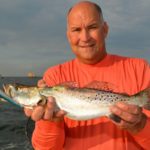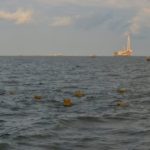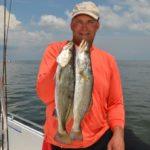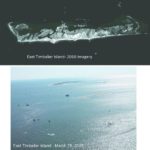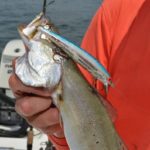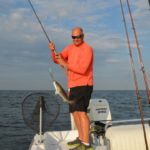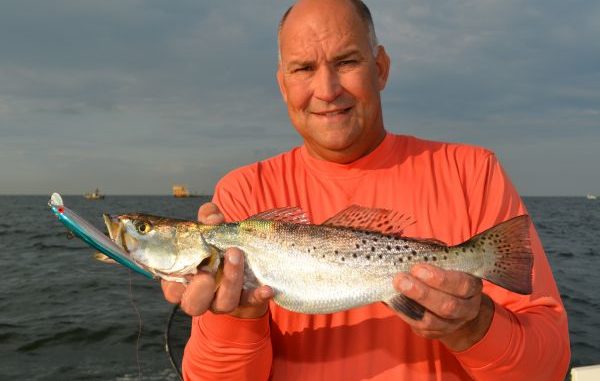
East Timbalier Island is all but disappeared beneath the waters of Timbalier Bay, but that doesn’t mean fish aren’t there. And this guide knows the best lure to get them to bite.
Getting up at 6 a.m. to go speckled trout fishing is a luxury I could get used to.
Well after daylight, I sauntered downstairs from my kitchenette at Bobby Lynn’s Marina in Leeville. Tracy “T.L.” Bayles, owner of Choctaw Guide Service (225-284-5256), had just launched his boat and flashed a big smile at me as I walked around the corner of the building.
Months before, the veteran guide cum über chef enticed me with tales of murdering specks on the rocks of East Timbalier Island with Bomber Long A shallow-running jerk baits, best known as largemouth bass lures.
It had been years since I fished the rock-ringed island, and I could just picture speckled trout slashing out of clear-green ground swells as they rolled up to the rocks.
As Bayles picked his way down cluttered Bayou Lafourche, we talked about the trail that led him here. Originally from Monroe, the 54-year-old built a cooking career working with some of the best chefs in the business.
He ended up in New York with a bad back, something he attributes to working 10 years in five-star restaurants. Being a chef is brutally hard work. He returned to Louisiana in 1995, and by 1999 was guiding fishermen out of Fourchon, where his family’s camp was and where he has fished since he was a kid.
He guided until Hurricane Katrina turned South Louisiana upside down in 2005. From then until recently, when he began guiding from Bobby Lynn’s, he cooked for a living. Even today, he is not completely out of the food business; in the off-season for fishing and between fishing charters, he is a private chef who splits time between Leeville and New Orleans.
“I’ll go into someone’s home,” he explained, “and prepare one to three or four meals, and put them in their refrigerator or freezer. They take them out and heat them.
“The average meal is a gourmet meal (See this month’s The Seafood Bible column for some of his recipes), but I will cook for special needs — Atkins Diet, Jorge Cruz diet and so forth. I don’t do things like crawfish boils, but everything else is up to the client.”
Below Leeville, Bayles turned right out of Bayou Lafourche into Havoline Canal. After it opened up into Timbalier Bay, he followed the orange channel markers to below marker No. 40, and then hooked left for the final run to East Timbalier Island — or what’s left of it.
As the boat neared the footprint of the island’s location, all that was visible was an intermittent line of suds where the modest surface chop was breaking on submerged sandbars or rocks.
Bayles explained that, of the original 7-mile island, only about three-quarters of a mile of the western end is left. The thought of the erosion of most of the big island made me wince.
Bayles swung the boat around through Penrod Slip, which was once a pass between Belle Pass (the mouth of modern Bayou Lafourche) and East Timbalier Island but is now marked only by a row of small breakers washing over a sandbar.
Shoaling sandbars, submerged rocks, man-made oil-field debris — the hazards impress me enough to ask Bayles how a person new to the area can find their way around.
“About the best way is with a GPS map,” he said. “A lot of them are out of date — fortunately.”
“That’s an advantage,” I asked?
“Absolutely,” Bayles said. “They still show where land was. Those are the areas to be careful in. Of course, you can always charter a guide.
“The best times for fishing East and West Timbalier (islands) are April into July and October into December.”
By his own admission, he loves to fish with artificial lures, but he usually carries live bait, as well: croakers and shrimp, and if he can’t get those, he will buy cocahoe minnows.
His favorite artificial lure is a Bomber Long A, but he will also often use a 5-inch Bass Assassin Die Dapper mounted on a Rockport Rattler jighead with a small split shot added to the hook shank for more weight.
“The wide gap on the hook allows the point to be buried in the bait. The buried hook on that rig is ideal for bouncing on the rocks and not getting hung up, — as much,” he said with a grin.
Bayles slowed the boat to a fast idle, scanning in both directions.
“I’m looking for bait,” he explained. “Mullets, pogies flipping, pelicans diving, gulls — not terns, gulls diving. A lot of time, when you can’t see the rocks underwater, the mullets will show you where they are because they school over them.”
Bayles explained that success is dictated by conditions.
“You need two things to fish out here: clear water and a clear sky,” he said. “You got to make the run (to know if those conditions exist); that’s the risk. It can be muddy all the way down and clear here, or vice versa.”
He targets specific periods of a day’s tidal movement.
“I generally like the last two hours of a tide and the first two hours of the next tide,” Bayles said. “The water is clearer. If the tide is real strong 1.2(-foot range) or more, it can muddy things up.
“Near the beginnings and ends of tides, the current isn’t as strong.”
Winds also are a concern.
“East wind conditions are least favorable, especially on the end of East Timbalier still sticking out of the water and near West Timbalier,” he said. “Two- to 3-foot seas are marginal. Anything more is unfishable.”
Such heavy seas are possible because the islands are on the edge of the open Gulf of Mexico.
First stop on this trip was at a bunch of gnarly piling stubs that protruded just above the water’s surface like menacing dragon’s teeth waiting for a careless boater. Bayles arched a blue-backed chrome Bomber toward the pilings. He snapped it a couple of times and paused it for a second or two.
It produced an immediate hit.
The next cast produced the same result, and so did the next.
He fished the lure vigorously, with almost vicious twitches. After the second yank, he paused it, and fish popped the bait as it began to rise toward the surface.
“This technique produces the most-consistent bite,” Bayles said, glancing over one shoulder as he reeled in another speck. “I can fish the lure as a topwater, too, but if I want topwater, I will go to Top Dogs or She Dogs.
“This is a really good method of fishing in rocks without getting hung up.”
I still hadn’t seen any rocks. My memory of East Timbalier from before Hurricane Katrina was of a long, sandy island ringed with an armored fringe of huge rocks sticking 2 to 3 feet out of the water.
The bite slowed and Bayles moved on. His fishing style was to ride his trolling motor until he found fish, and then drop the anchor.
He worked all sides of a spot, cautioning that speckled trout can be found on any side of a structure. He said that, when he has several people on the boat, he recommends everyone use different baits — plugs, soft plastic or live bait — until they find out what the fish want.
Bayles stopped to probe a featureless spot he had found two months earlier under diving birds. He claimed it held a submerged rock pile. It, too, held speckled trout.
The 6-foot-2-inch, slender, soft-spoken guide was low key. No screaming or yelling here. But it was easy to pick up his excitement.
“Oh my, look at that,” he hissed. “In clear water like this, you actually get to see the fish flash and take the bait. It’s an adrenaline rush.”
He nabbed each flouncing speckled trout he flipped into the boat — ching-ching — with the flashing blades of his fish grabber, looking for all the world like Edward Scissorhands. The experienced guide wasn’t taking any chances that a slippery, wiggling 2-pound trout would drive treble hooks into his bare hands.
A half-dozen fish later, he is on the prowl again, slowly putt-putting through a seemingly endless sea of oil-field wells and platforms. I commented on all the choices of structures to fish.
“There is even more that you can’t see — most especially rocks,” Bayles said matter-of-factly. “There is so much structure out here that holds fish that finding them is a challenge.
“There are lots of places that a fish can be and not see a bait.”
To show me the ring of rocks around the now-gone island, he idled the boat over the submerged rock ring onto the now-gone island with his depth sounder. It was amazing. The rocks I remembered being well above the water’s surface now ranged from just below the surface to 7 feet deep. What was once an island is now under 8 to 18 of water.
“The rocks do still stick out of the water in a couple of places,” Bayles said. “Let me show you one of them.”
Finally, I saw rocks — a double-crowned pile of barnacle-encrusted, algae-covered boulders that seemed to scream “fish here.”
Strangely, the spot didn’t produce a single strike.
One more stop was all it took for Bayles to finish out his limit. It was a fun stop.
“I got to see that one hit it two or three times,” he said. “That’s one of the fun things that I really like about Bomber fishing.”
As he slipped the last fish in the box, I asked what he liked better about speckled trout: catching them or cooking them. His answer was predictable, but eloquent.
“I like them both,” Bayles said. “I never tire of the quest — hunting for them and finding them. I also like cooking for people. I like cooking for people who love good food.
“These will go to my girlfriend’s family. I freeze them in buttermilk. I like to freeze my quail and doves in orange juice. They taste better when I grill them.”
With Tracy Bayles, it’s always about food.
